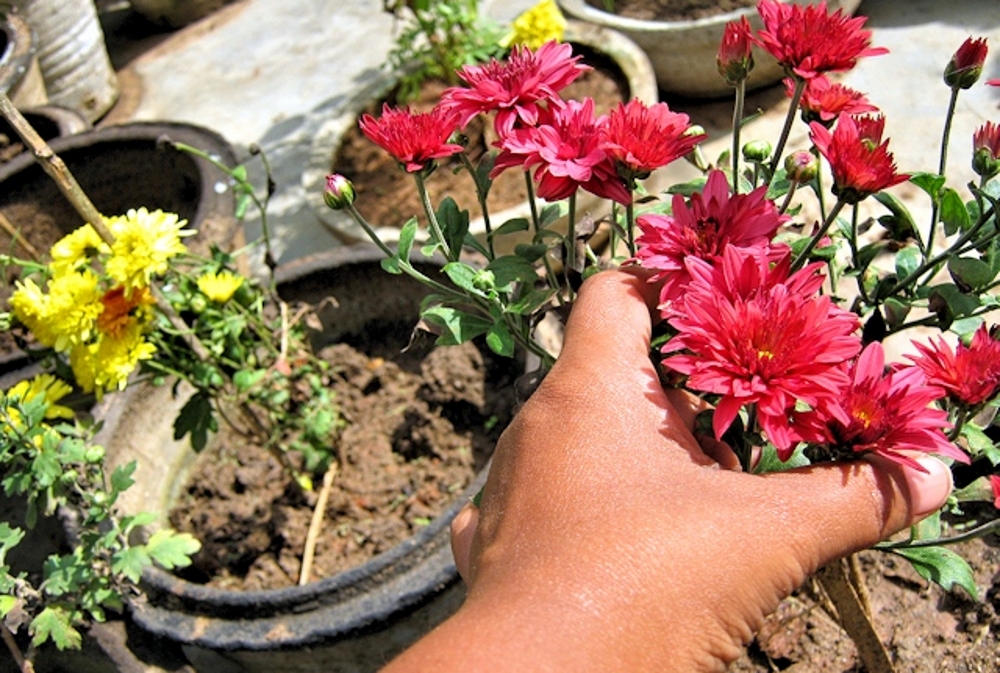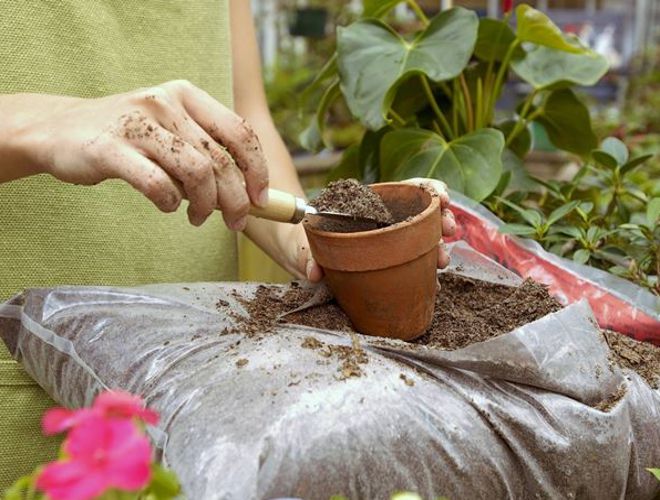Content:
To ensure the active growth and flowering of chrysanthemums, it is necessary to comply with a certain list of requirements for growing and caring for the crop. It is important to follow the rules of planting, watering, pruning, transplanting a plant, as well as protecting chrysanthemums from pests and diseases.
Outdoor chrysanthemum care
Caring for the plant involves regular feeding: after watering, the flower is fertilized with a mullein. Fertilizers containing phosphorus contribute to the formation of strong leaves and stimulate the longest flowering. Chrysanthemum leaves are sprayed with nitrogen-containing fertilizers. It is not recommended to add them to the soil, since frequent watering with large amounts of water leads to the rapid leaching of nutrients. Nitrogen fertilizers are especially necessary for flowers during the active growth of buds.
Chrysanthemum care is also about protecting the plant from diseases and pests. When the first signs of aphid damage appear, you should not wait for the buds to bloom - you need to fight the pest until this moment, otherwise you cannot cope with the parasite later.
The transplanting process and the wintering period require special attention. The plant must be prepared before the onset of the first stable cold snap. At this time, the chrysanthemum is pruned, the soil around the flower is piled up and treated with humate. On the first day of frost, the plant is covered with spruce branches for the winter.
Chrysanthemum transplant in the open field
Since chrysanthemums are perennial plants, they are able to withstand a long period of cold weather even in the open field. In this case, it is very important to move the flower to another place from time to time. Thanks to this, chrysanthemums will grow and develop normally, and the flower bed will retain an attractive appearance.
The transplant procedure is usually carried out immediately after the snow melts. For the result to meet expectations, it is important to know how and when to transplant chrysanthemums correctly.
How to transplant chrysanthemum in spring
Since chrysanthemum is characterized by active growth, during the development and formation of a flower, the soil under it is greatly depleted, the amount of nutrients in it is sharply reduced. This situation will ultimately negatively affect the state of culture. Therefore, the plant must be periodically moved to another location.
When is it better to replant chrysanthemums - in spring or autumn? Experienced gardeners recommend the first option, since transplanting chrysanthemums is stressful for them, and if you move flowers before the onset of cold weather, they will not get strong enough and risk not surviving the winter. The second reason: the spring transplant is a fairly simple event. In the spring, after the snow has melted, the soil is moist and soft - under such conditions, it is much easier to dig up a flower. In addition, the likelihood of damage to the root system is reduced, while removing the crop from hard, frozen soil in the fall is difficult and leads to root injury.
Transplanting must be done before the plant begins to wilt due to the impoverished soil. This must be done in advance, until the flower withers. At first, when the age of the flower does not exceed 2-3 years, the transplant is carried out once a year. Then the procedure is carried out every 6 months.
The exact time of the work depends on the climate, but in any case, the plant can be “relocated” only at the moment of warm weather.
The transplant process includes the following sequence of actions:
- Choosing a landing site. Beds exposed to sunlight are best suited for this. Groundwater should not pass too high, otherwise a little sand should be added to the holes.
- Flower preparation. Before removing the culture, it is recommended to moisten the ground, then it will be much easier to dig up the chrysanthemum and the roots will remain intact. Before transplanting, the bush is divided into several parts, cutting in such a way that roots with shoots are present on each part.
- Transfer. In advance, you need to prepare holes, the depth of which would be 18-22 cm, and the distance between them was at least 50 cm. After placing flowers there, chrysanthemums are sprinkled with earth.
- Watering. The first 2-3 weeks the soil in the new place is thoroughly and regularly moistened, preventing stagnation of the liquid.
- Top dressing. Fertilizers can be applied 2-3 days after transplanting. As such, nitrogen and phosphorus compositions are used.
It should be borne in mind that only winter-hardy plant varieties are allowed to transplant in this way. Chrysanthemums dug out before the onset of cold weather and planted in pots, which were in the basements in winter, must be prepared in advance.
Autumn transplant
Chrysanthemum is a rather delicate plant and, despite its winter hardiness, is still sensitive to cold weather. In order not to cause harm when transplanting chrysanthemums to another place in the fall, it is important to follow all the necessary recommendations.
- Before you "relocate" the chrysanthemum, you need to choose a good place for it. As such, a sunny plot of land with deep groundwater is suitable.
- The soil in the new location should not be too acidic.
- Hard and heavy soil should be fertilized with manure, peat or compost.
- The roots around the bush are pruned with a shovel, due to which there will be a rapid growth of roots, which will easily take root in another area.
- Before removing the chrysanthemum, the flower in the old place is watered with plenty of water. Then the culture is moved along with the excavated piece of soil.
- After transplanting, fertilizers are applied to the soil.
- 2 weeks after transplanting, the soil is filled up (the old one will noticeably sag by this time due to watering).
- The soil in the hole does not need to be pressed down strongly, otherwise the roots may be damaged and the plant will not take root.
When preparing the land, it is important not to overdo it with feeding. An excessive amount of fertilizer will negatively affect the state of the flower: as a result of too active growth, the culture will quickly fade and wither before the onset of winter.
The whole procedure is carried out before the onset of cold weather.
Chrysanthemum in a pot: care after purchase
The first thing to look for after purchasing a flower is lighting and temperature. Homemade chrysanthemums are recommended to be placed on the west or east window. Another option is to put the flower on the balcony, which is well lit and, if there is a loggia, is regularly ventilated.
Caring for a potted chrysanthemum after purchase also presupposes compliance with the following conditions. Recommended temperature regime for growing a flower: 20-23 degrees in summer, 15-18 in autumn and 3-8 in winter. Chrysanthemum tolerates hot summers well, provided that it is in a shaded, ventilated area. The plant is also able to withstand short frosts down to -3 degrees.
Note! The culture prefers short daylight hours (8-10 hours) and cool weather. These conditions are fully consistent with the autumn season.
As for watering, it should be regular, plentiful, but no frills. You do not need to fill the plant. The soil is moistened after the top layer has dried. Chrysanthemum feels comfortable in high humidity. Therefore, it is recommended to regularly spray the plant with water, and it is not difficult to care for it.
When to transplant chrysanthemums at home
Garden mixture is great for transplanting home flowers. Fertilizers are used as top dressing, consisting of peat, humus and earth in the same proportion. Since the root system of the plant is shallow, the transplant box may not be too bulky. The floor of the container must have drainage holes. Before transplanting, it is recommended to disinfect the soil with formalin or warm it up.
Potted chrysanthemum purchased in October should not be placed in open ground immediately. Most likely, the plant will not have time to take root in a new place before the onset of winter and will die. Therefore, it is best to leave the flower in a pot and store it in a warm room until spring.
After the end of flowering, the flower is cut off, leaving about 15 cm on the surface of the box. The container is wrapped in a thick layer of fabric so that the culture does not germinate prematurely. In this form, the plant is sent to the basement or cellar for wintering. Soil moisture should be minimal. In the spring, the container is transferred to a warmer and lighter place. By this time, the chrysanthemum will begin to give its first shoots. As soon as the threat of frost has passed, the flower is moved from the pot to fresh soil.
A week after transplanting, the flower is fed with a nitrogen-containing fertilizer. The next feeding is carried out every 10 days. As soon as shoots with several young leaves appear, the tops of the plant are pruned, creating conditions for the future formation of the bush.
Tips and tricks from experienced florists and gardeners
Chrysanthemums that have wintered indoors should not be planted in open ground without prior preparation. They need a little time to get stronger and adapt to new conditions. Flowers need hardening - for this, the plants are taken out into the street in pots and only after 7-10 days are planted in the garden.
After wintering, it is allowed to plant the chrysanthemum in the old place, since over the past time the soil has had time to "rest". The holes are pre-covered with ash mixed with earth. Plants need regular watering. You can feed the flower 2 weeks after its "resettlement" in the open ground. If it is assumed that the plant will be tall, it is necessary to establish a support for it in advance, otherwise at the slightest breath of wind the chrysanthemum may break.
Thus, observing all the recommendations listed in the article, the transplant procedure will be successful: the plant will quickly take root in a new place and will actively develop and bloom throughout the season.
















